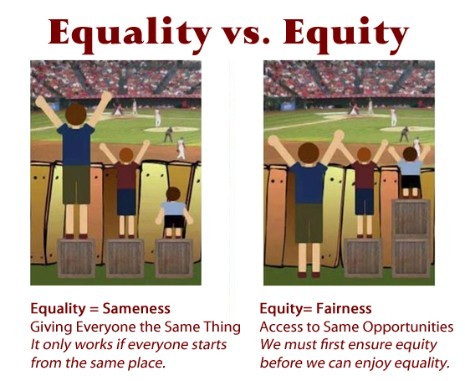Equitable Access
-
One of SVUSD's goals is to provide equitable access and opportunities, and close the Achievement Gap.
In order to assure that every student in this district has access to and the opportunity to learn 21st century skills, the district must assure that every school reflects the diverse community in which we live; including the diversity of student learning levels and ability, economic status, culture and ethnicity, and that every teacher and principal is prepared to provide the 21st century skills to every learner within their school.

-
EXAMPLES OF EQUALITY and EQUITY
Celery Sticks and Shoes
You as the teacher have been assigned the task of distributing celery sticks to all students equally. You need to divide the total number of celery sticks by the total number of students in the class and arrive at the number to be given to each child. This is known as the concept of “equality.”
But if you ask students to take off their shoes, mix them up, and return two different shoes to each student, you will find every student complaining, even though you followed the concept of equality! Why? Because now the shoes do not fit the feet of the children. Some with large feet received smaller shoes, while others with small feet received larger shoes. Providing the right shoes to the right feet – some large, some small – is “equitable”, while providing shoes to every student (“one size fits all”) might be equal – but not equitable.
A Turkey Dinner
A second example demonstrating the principal difference between equity and equality, would be carving up a turkey at a family’s dinner table. “Equality” means everybody -- father, mother and children – would receive the same sized slice. “Equity”, on the other hand, means taking a sensible portion, and dividing it according to their needs, i.e. larger sized pieces for the adults and smaller sized pieces for the children.
EXAMPLES USING EQUALITY AND EQUITY IN THE CLASSROOM
Equality
- When students raise their hands to answer a question, call on boys and girls and children of all races as equally as you can.
- Don't stereotype tasks as being feminine or masculine. Assign girls to do tasks that were traditionally masculine, and boys to do tasks that were traditionally feminine.
- Encourage girls to do well in math and science, and boys to shine at reading and writing.
Equity
- Provide extra school supplies to children whose families might not have resources to afford them.
- Have extra snacks available for those students who don’t have one or forgot their snack at home.
- Provide extra time in smaller groups for students who need more support.
-
NONDISCRIMINATION STATEMENT
Sonoma Valley Unified School District prohibits, at any district school or school activity, unlawful discrimination, including discriminatory harassment, intimidation, and bullying, targeted at any student by anyone, based on the student's actual or perceived race, color, ancestry, nationality, national origin, immigration status, ethnic group identification, ethnicity, age, religion, marital status, pregnancy, parental status, physical or mental disability, sex, sexual orientation, gender, gender identity, gender expression, or genetic information, or association with a person or group with one or more of these actual or perceived characteristics.







